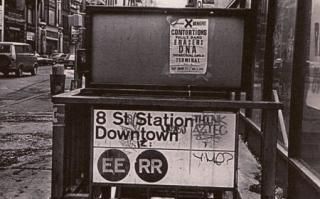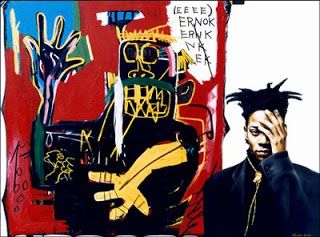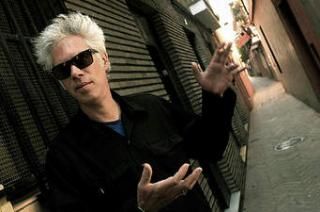Look Back In Anarchy:
The No Wave Story Part I
 Entrance to the 8th Street subway station in downtown New York with a Contortions/DNA concert flyer (1978)
Entrance to the 8th Street subway station in downtown New York with a Contortions/DNA concert flyer (1978)
From the
Urban Dictionary:
Quote:
1. No Wave
No Wave was a short-lived but influential offshoot of punk rock centered in New York City during the late 1970s and early 1980s. The term No Wave was partly a satiric wordplay rejecting the commercial elements of the then-popular New Wave genre, and also a declaration of the music's experimental nature: No Wave music belonged to no fixed style or genre.
In many ways, No Wave is not a clearly definable genre. There is, for example, no fixed harmony as in most rock music and blues music. There are some elements common to many No Wave performers, including abrasive atonal sounds, strong emphasis on repetitive rhythm, and more emphasis on mood and texture than on conventional melody. Lyrics often focused on nihilism and confrontation, or were puzzlingly abstract.
|
The single person most responsible for the creation of the No Wave musical genre was Brian Eno. As the story goes, the British musician and producer was visiting New York in early 1978 to master the Talking Heads album
More Songs About Buildings and Food. During his stay, Eno attended an underground music festival hosted by the New York Artist's Space on the Lower Eastside. The final two days of the festival featured DNA and the Contortions on Friday, followed by Mars and Teenage Jesus and the Jerks on Saturday. Eno was in the audience for both shows and was so impressed by what he heard, he wanted to produce an album documenting the music of these bands.
Eno convinced Island records to sign on to the project which he titled
No New York an anthology of what he termed "no wave" music. All my sources indicate that it was Eno who first introduced the term "No Wave" into the musical vernacular, with his groundbreaking
No New York anthology.
 Album cover of Eno's No New York anthology
No New York
Album cover of Eno's No New York anthology
No New York was released in the spring of 1978 on on the Island Records susidiary label Antilles Records without any notice on the Billboard charts and generally negative reviews from the mainstream media.
Critic Richard C. Walls writing for Creem :
Quote:
|
No New York is the most ferociously avant-garde and aggressively ugly music since Albert Ayler puked all over my brain back in - what? - 64. If you're intrepid enough to want to hear this stuff (a friend, 3/4 into the first side, complained that the music was painful - she wasn't referring to any abstract reaction, she was grimacing), be advised that Antilles is a division of Island Records, which ain't exactly Transamerica Corp. You'll probably have to make a little effort to procure it, because there's no way it's going to come to you.
|
As it turns out
No New York has become one of the most influential albums of the post-punk music. The bold experimental ideas behind No Wave music became a source of inspiration for many indie and electronica artists, over the past three decades.
No New York sold less than 10,000 copies world wide, but it seems nearly every influential indie artist in the U.S. and U.K. purchased a copy of it and integrated elements of No-Wave theory into their own musical vision.

 Neo-expressionist visual artist John-Michael Basquiat (left) and film director Jim Jarmusch (right) both identified themselves as members of the No Wave movement
Neo-expressionist visual artist John-Michael Basquiat (left) and film director Jim Jarmusch (right) both identified themselves as members of the No Wave movement
The size of the No Wave genre was microscopic and centered on a small group of bands who played on the downtown New York rock music scene in the late Seventies and early Eighties. There was an additional component of of downtown based visual artists, performance artists and film makers who embraced the Dadaist style and the nihilistic attitude of No Wave. Film maker Jim Jarmusch and primitivist painter Jean-Michel Basquiat both self identified as members of the No Wave movement.
Below is a fairly comprehensive list of bands that were associated with the No Wave movement. A few No Wave bands on my list came to be associated with experimental indie rock after the hey day of No Wave was over. However all the artists on my list were considered No Wave bands when they first appeared on the downtown scene:
- Suicide- The duo consisting of singer Alan Vega and keyboardist Martin Rev predates the No Wave movement but nearly every No Wave musician cites Suicide as the band that inspired the No Wave movement.
- DNA- One of the earliest No Wave bands founded by Arto Lindsay.
- Teenage Jesus & the Jerks- An early No Wave founded by Lydia Lunch & James Chance.
- Richard Hell & the Voidoids- One of the earliest American punk bands which included vocalist Richard Hell, guitarist Jody Harris and the influential guitarist Robert Quine. Quine played guitar in several editions of Lou Reed's band and was one of New York's busiest session players.
- The Contortions- Band members included James Chance, Jody Harris & Pat Place.
- 8 Eyed Spy-A band formed No Wave queen, poet and vocalist Lydia Lunch, guitarist/saxophonist Pat Irwin & bass player George Scott.
- Bush Tetras- Founded by Contortionist guitarist Pat Place and No Wave poetess & vocalist Cynthia Sley.
- Lounge Lizards- A self proclaimed "fake jazz" band founded by DNA guitarist Arto Lindsay & saxophonist John Lurie.
- Del Byzanteens- Band founded film maker Jim Jarmusch who sand and played keyboards.
- The Raybeats- An all instrumental band founded by Jody Harris of the Contortions & Pat Irwin of 8 Eyed Spy.
- Theoretical Girls -Founded by avant garde classical guitarist Glenn Branca.
- Sonic Youth- Kim Gordon & Thurston Moore's experimental rock band first gained their notoriety playing at No Wave events at the Artist's Space.
- Mars- Founded by Sumner Crane and Nancy Arlen. Among the bands profiled on Eno's No New York anthology.
- Half Japanese- Originally founded in Ann Arbor Michigan by brothers Jad and David Fair, Half Japanese became regulars on the downtown No Wave scene in the early Eighties.
- John Zorn- The brilliant guitarist and soundtrack composer was considered to be No Wave early on in his career. Zorn played several No Wave events at the Artist's Space and the Knitting Factory in the late Seventies and early Eighties.
- Swans- Like Sonic Youth, Swans were born during the heyday of New York's no wave reaction to punk rock, on the Lower East Side. Swans frequently partnered with Sonic Youth for live gigs at performance spaces like the Knitting Factory.
Like jazz musicians, No Wave artists frequently jumped from band to band and the entire scene was incestuous. For instance Jody Harris played guitar in four different No Wave bands and Arto Lindsay played in three different No Wave bands.
More No Wave in My Next Journal Entry
Part II of
Look Back In Anarchy: The No Wave Story will include a list of important No Wave albums and reviews of live shows by Contortions, 8 Eyed Spy and the Bush Tetras that I attended in 1979. Those three No Wave shows were among the earliest live music shows I attended when I moved to the East Coast in late 1978.